At this point, is Nutella a spread or a lifestyle? For more than 60 years, the chocolate-hazelnut delicacy has elevated the taste of toast, croissants, and milkshakes worldwide. It’s even been used to give savory snacks like pizza or grilled cheese a dessert twist, and several official Nutella cafes across the United States serve up baguettes, pound cakes, and gelato to die-hard chocoholics. But few know the fascinating — and surprisingly political — tale behind its ancestor: gianduia.
Let’s travel to Turin, a northwestern region of Italy that’s the capital of Piedmont. Head southwards and you’ll reach the hilly landscape of the Langhe, a region famed for its vineyards, gastronomy, and yes, hazelnuts, or as the locals call them, tonda gentile delle Langhe (the sweet round nut of the Langhe). In the 1800s, Napoleon tried to conquer Europe — a move that would prove monumental for the future of sweet treats. His Continental System forbade French allies from trading with Britain, throwing cocoa supplies into crisis. But local confectioners came to save the day, blending cocoa with nuts for a cheaper alternative.
And so, gianduia came to be. The name bursts with regional pride, taking after a jolly, wine-loving character in Italy’s commedia dell’arte who represented the Piedmont region. Legend has it he’d hand out sweets to children and the sick before Lent, and since, revelers masquerading as the gentleman would dish out the foil-wrapped, tricorn-hat-shaped confections at Italy’s annual Carnival; not all heroes wear capes, some wear painted masks. Later in the century, local legends Michele Prochet and Ernesto Alberto Caffarel discovered pre-roasting the hazelnuts enriched the flavor, and now, iconic brands like Venchi and Gobino stock the chocolate, which, by law, has to be at least 20% hazelnut to bear the gianduia badge.
How did gianduia become Nutella?
So how did the luxury with a local heart win over the world? Well, it all comes down to another conflict — WWII — which, like the Napoleonic Wars beforehand, caused a cocoa shortage. Italian mastermind Pietro Ferrero took matters into his own hands, and created pasta gianduja, a version of the initial treat packaged in wrapped slices. The pastry whiz, who was so obsessed with the product that he’d wake his wife up at midnight to sample it, then invented Supercrema — a smoother version that included vegetable oil.
Chocolate in Italy had previously been reserved for special occasions like Christmas, but the innovation catered to the Italian palate by creating an affordable variation that could be spread on bread. Sold in jars, the “traditional and luxurious shape” yet “modern, cheap, functional” plastic cap were a winning marketing combo, according to cultural psychology professor Roberta Sassatelli (via BBC).
Sound familiar? The paste was renamed Nutella in 1964. Fast-forward to the 21st century, and the company has catapulted to confectionary stardom — a far cry from the humble origins of that first jar. In 2013, the amount of Nutella produced was enough to wrap round the world 1.4 times, and in 2015, one jar of Nutella was sold every 2.5 seconds. So next time you tuck into your Nutella-slathered sandwich (it even adds a delicious twist to French toast), or boost your hot chocolate with a Nutella swirl, take a second to reflect on the carnivals, wars, and Italian maestros who made the treat what it is today.






